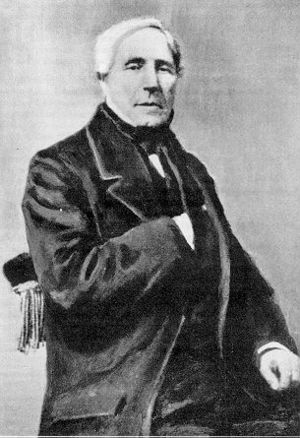Jean Léonard Marie Poiseuille facts for kids
Quick facts for kids
Jean Léonard Marie Poiseuille
|
|
|---|---|
 |
|
| Born | 22 April 1797 |
| Died | 26 December 1869 (aged 72) |
| Nationality | French |
| Alma mater | École Polytechnique |
| Known for | Poiseuille's law |
| Scientific career | |
| Fields | physicist and physiologist |
Jean Léonard Marie Poiseuille (born April 22, 1797 – died December 26, 1869) was a French scientist. He was both a physicist and a physiologist. This means he studied how things work in nature (physics) and how living things work (physiology). Poiseuille is famous for his work on how liquids flow, especially blood. He was born in Paris, France, and he also passed away there.
Contents
Studying Fluid Movement
Jean Poiseuille studied at the École Polytechnique in Paris from 1815 to 1816. He learned a lot about physics and mathematics. In 1828, he earned his science degree. His main interest was understanding how human blood flows inside very narrow tubes.
Understanding Blood Flow
Poiseuille did many experiments to figure out how liquids move through small pipes. In 1838, he discovered an important rule about this. He published his findings in 1840 and 1846. This rule is now called Poiseuille's law. Sometimes it is also called the Hagen–Poiseuille equation, because another scientist named Gotthilf Hagen also worked on similar ideas.
What Poiseuille's Law Explains
Poiseuille's law helps us understand laminar flow. This is when a liquid flows smoothly without mixing or swirling. Think of water moving slowly and steadily through a straight pipe. This law is very useful for understanding how blood flows in tiny blood vessels, like capillaries and veins.
The law helps to calculate the pressure needed to make a liquid flow through a tube. It considers things like:
- How long the tube is.
- How wide the tube is.
- How thick or "sticky" the liquid is (this is called viscosity).
- How fast the liquid is flowing.
The Poise Unit
Because of Poiseuille's important work, a unit of viscosity was named after him. This unit is called the poise. It is part of an older system of measurement. While the "poise" is still used, the standard unit for viscosity in the modern SI is the pascal-second (Pa·s).
See also
 In Spanish: Jean Léonard Marie Poiseuille para niños
In Spanish: Jean Léonard Marie Poiseuille para niños

